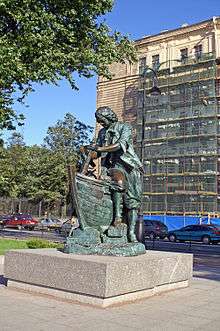Grand Embassy of Peter the Great

The Grand Embassy (Великое посольство in Russian) was a Russian diplomatic mission, sent to Western Europe in 1697–1698 by Peter the Great.
The goal of this mission was to strengthen and broaden the Holy League, Russia's alliance with a number of European countries against the Ottoman Empire in its struggle for the northern coastline of the Black Sea, hire foreign specialists for Russian service, and to order and acquire military supplies and weapons. Officially, the Grand Embassy was headed by the "grand ambassadors" Franz Lefort, Fedor Golovin and Prokopy Voznitsyn. In fact, it was led by Peter himself, who went along incognito under the name of Peter Mikhailov. At 6' 8" Peter was one of the tallest men in Europe, a fact very hard to disguise.
Peter conducted negotiations with Friedrich Casimir Kettler, the Duke of Courland, and concluded an alliance with King Frederick I of Prussia. He arrived in the Dutch Republic at the start of August 1697, where he worked incognito as a shipbuilder. He later used the knowledge acquired during this period to modernise the Russian navy.[1]
He met with William III, who governed both the Netherlands and England, in September, and the States-General in October. Peter failed to expand the anti-Ottoman alliance, however, and the Grand Embassy had to limit itself to acquiring different equipment and hiring foreign specialists especially in military and naval affairs. They formed the basis of his modernizing the Russian army and navy.[2]
On invitation of William III, Peter and part of the mission also went to England in January 1698, where he visited Gilbert Burnet and Edmond Halley in the Royal Observatory, the Royal Mint, the Royal Society, the University of Oxford, and several shipyards and artillery plants. The embassy stayed in Sayes Court (adjacent to the Deptford Dockyard) belonging to John Evelyn and did great damage to both house and grounds.[3]
On the way back to Russia, the Grand Embassy conducted fruitless negotiations in Vienna with Russia's former allies in the Holy League, the Austrian foreign minister and the Venetian ambassador, trying to prevent Austria's separate peace treaty with Turkey. An intended visit to Venice was cancelled due to the news about the Streltsy Uprising in Moscow and Peter's hasty return to Russia.
The Grand Embassy failed to accomplish its main goal, but it gathered valuable information about the international situation, ascertained the impossibility of strengthening the anti-Turkish coalition due to the imminent War of the Spanish Succession, and brought back the plans for gaining access to the Baltic Sea. On his way back to Russia, Peter the Great met with Augustus II of Poland and conducted negotiations with him, which would form the basis for the Russo-Polish alliance against Sweden in the Great Northern War.
See also
References
- ↑ Lindsey Hughes, Russia in the Age of Peter the Great (Yale University Press, 1998) pp 13-24.
- ↑ Hughes, Russia in the Age of Peter the Great (1998) pp 63-91.
- ↑ This is the house that Peter the Great destroyed while visiting
Further reading
- Jacob Abbott (1869). History of Peter the Great, Emperor of Russia. Harper. pp. 141–51.
- Grey, Ian. Peter the Great: Emperor of All Russia (1960) pp 99-125 online.
- Hennings, Jan. "The Semiotics of Diplomatic Dialogue: Pomp and Circumstance in Tsar Peter I's Visit to Vienna in 1698." International History Review 30.3 (2008): 515-544.
- Hughes, Lindsey, ed.. Peter the Great and the West: New Perspectives Palgrave MacMillan, 2001.
- MacGregor, Arthur. "The Tsar in England: Peter the Great's Visit to London in 1698." Seventeenth Century 19.1 (2004): 116-147. online; online
- Matveev, Vladimir. "Summit diplomacy of the seventeenth century: William III and Peter I in Utrecht and London, 1697–98." Diplomacy and Statecraft 11#3 (2000): 29-48.
- Massie, Robert K. Peter the Great: his life and world (2012). a popular biography based on limited sources.
| Wikimedia Commons has media related to Grand Embassy of Peter the Great. |